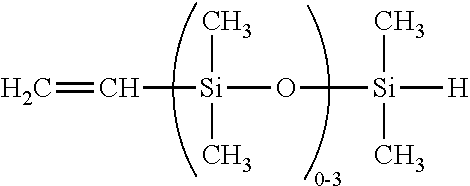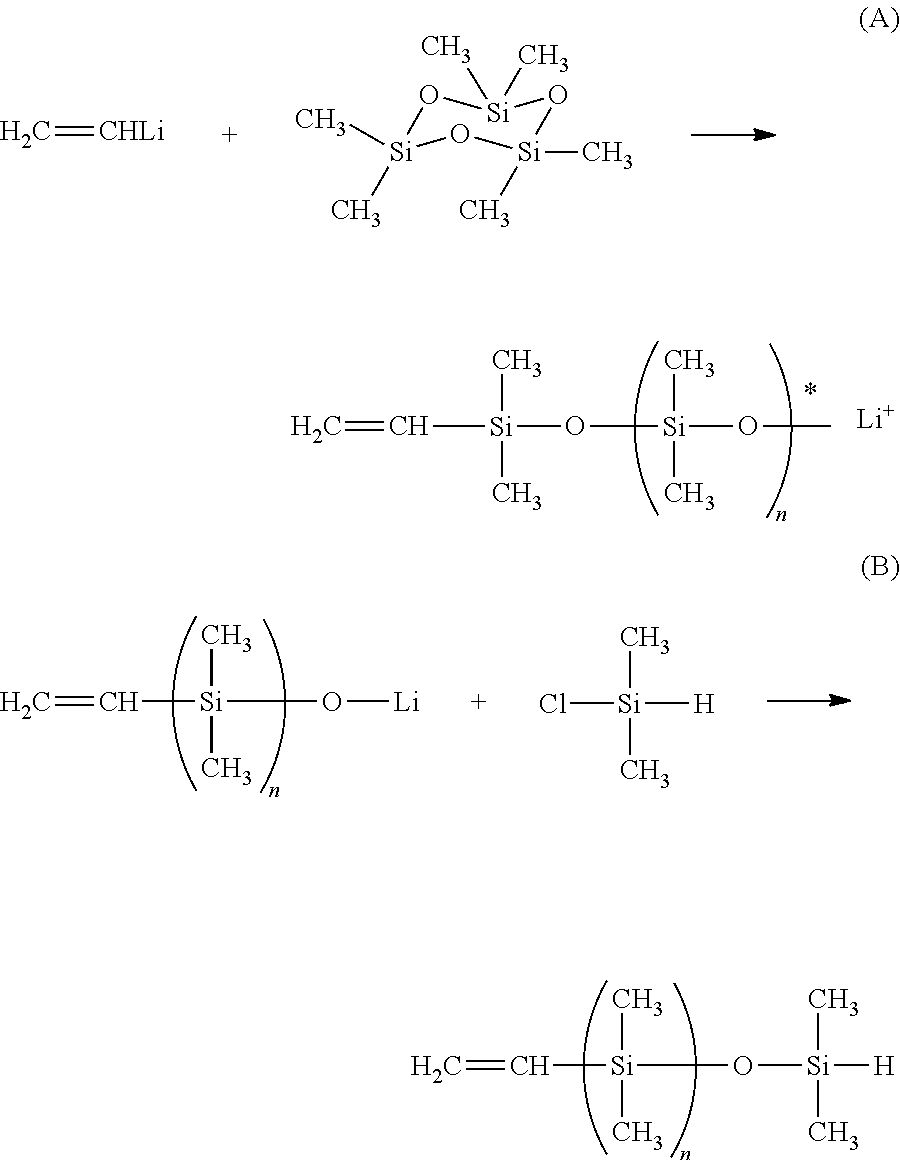Dual functional linear siloxanes, step-growth polymers derived therefrom, and methods of preparation thereof
a technology of functional linear siloxanes and step growth polymers, which is applied in the field of dual functional linear siloxanes, step growth polymers derived therefrom, and methods of preparation thereof, can solve the problems of inability to achieve high molecular weight, and inability to achieve high purity for step growth polymerization
- Summary
- Abstract
- Description
- Claims
- Application Information
AI Technical Summary
Benefits of technology
Problems solved by technology
Method used
Image
Examples
example 1
Comparative Example
[0026]This Example replicates the procedure described by Shintani et al., Polymer Bulletin; 37:705-710 (1996). 20 g of vinyltetramethyldisiloxane were mixed with 3-4 drops (˜0.1 g) of Karstedt catalyst (see Example 1 of U.S. Pat. No. 3,715,334) containing ˜2 wt % platinum. Within 3 minutes, an exotherm was observed and the viscosity increased. The mixture was maintained at 50° C. for 4 hours. The mixture increased in viscosity from ˜1 cSt to ˜50 cSt. After this time, no further increase in viscosity was observed.
example 2
Synthesis of Monovinyl-Monohydride Terminated Polydimethylsiloxane (DP=200)
[0027]A 5 L 4 neck flask equipped with an overhead stirrer, pot thermometer, reflux condenser, and addition funnel was blanketed with nitrogen and charged with 6.9 g (0.027 moles) of trivinyltrimethylcyclotrisiloxane and 110 g of hexane and then sparged with nitrogen for 30 minutes. N-butyl lithium (30 ml of 2.61M in hexane solution) was added to the reaction mixture via an addition funnel over 10 minutes, with an exotherm of 7° C. The mixture was stirred for one hour, during which time the consumption of greater than 95% of the trivinyltrimethylcyclotrisiloxane was observed. A solution of 1158 g (5.2 moles) of hexamethylcyclotrisiloxane in 700 g of hexane was added to the reaction mixture at 20° C., followed by the rapid addition of 145 g of dimethylformamide (DMF). A slight exotherm was observed, pot temperature rose from 20° to 28° C., and the mixture was stirred for one hour.
[0028]The capping reaction was...
example 3
Synthesis of Monovinyl-Monohydride Terminated Polydimethylsiloxane (DP=50)
[0029]A 5 L 4 neck flask equipped with an overhead stirrer, pot thermometer, reflux condenser, water bath, and addition funnel was blanketed with nitrogen and charged with 39.6 g (0.15 moles) of trivinyltrimethylcyclotrisiloxane and 100 g of hexane and then sparged with nitrogen for 30 minutes. Methyl lithium (140 ml of 3.22M in diethoxymethane solution) was added to the reaction mixture via an addition funnel over 15 minutes. After an exotherm of 5° C. was observed, a cooling bath was used to maintain temperature below 40° C. during the methyl lithium addition. The mixture was stirred for one hour, during which time the consumption of greater than 95% of the trivinyltrimethylcyclotrisiloxane was observed. At the end of this period, the cooling bath was allowed to warm and the temperature of the reaction mixture was allowed to return to 25° C. Subsequently, a solution of 1671 g (7.5 moles) of hexamethylcyclotr...
PUM
| Property | Measurement | Unit |
|---|---|---|
| polydispersity | aaaaa | aaaaa |
| temperature | aaaaa | aaaaa |
| molecular weights | aaaaa | aaaaa |
Abstract
Description
Claims
Application Information
 Login to View More
Login to View More - R&D
- Intellectual Property
- Life Sciences
- Materials
- Tech Scout
- Unparalleled Data Quality
- Higher Quality Content
- 60% Fewer Hallucinations
Browse by: Latest US Patents, China's latest patents, Technical Efficacy Thesaurus, Application Domain, Technology Topic, Popular Technical Reports.
© 2025 PatSnap. All rights reserved.Legal|Privacy policy|Modern Slavery Act Transparency Statement|Sitemap|About US| Contact US: help@patsnap.com



